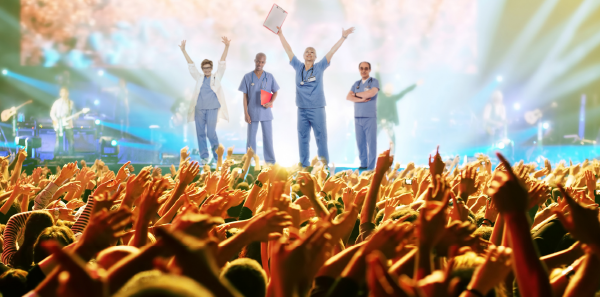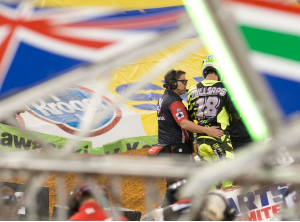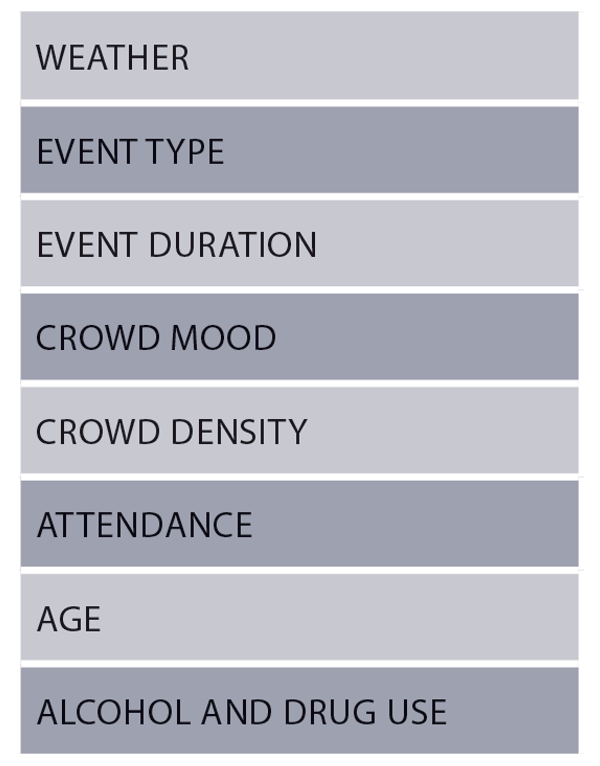
The term “mass gathering” refers to a variety of different events including music festivals, concerts, state fairs, political rallies, sporting events like the Olympics and football games, public exhibitions, and the recent Pokémon GO game sensation. Mass gatherings are occurring more frequently globally.1 While the majority of attendees who seek medical attention have minor injuries or illnesses and commonly remain at the event, deaths are not infrequently reported in the academic and gray literature (ie, white papers and government documents).2,3 At music festivals between 1999 and 2014, 722 deaths were reported.3 Thus, onsite medical care has become an integral component of mass gatherings, and provisions for onsite resuscitation are critical to improve patient outcomes.4
Explore This Issue
ACEP Now: Vol 36 – No 04 – April 2017
James R. Kennedye MD, MPH, FACEP, of Tulsa, OK, helps Davi Millsaps up after a crash on the track during the Monster Energy Supercross races in Arlington, Texas.
Image Credit: Renée Fernandes/ReneeMedia
There is not a uniform consensus regarding the definition of a mass gathering. A mass gathering is commonly defined by a single characteristic of the event: the number of attendees. Some define a mass gathering as an event with more than 1,000 attendees, while others argue the minimum is 25,000 persons.5,6 Strictly defining a mass gathering by the number of attendees incorrectly suggests that attendance is the most important variable of an event. A broader definition of a mass gathering would be more useful. One authority defined a mass gathering as an event at which persons gather and the potential exists for delayed response to emergencies because of limited accessibility or the environment.7 The potential for delayed response requires advanced planning and preparation to allow timely access to appropriate medical care.
Mass-Gathering Medicine Literature
Reviews of mass-gathering medicine (MGM) literature repeatedly note that the existing literature is largely anecdotal or descriptive.2,7 MGM terminology and concepts are inconsistently defined and applied in the literature, leading to a relatively limited and non-standardized evidence base.8 For instance, event medicine and MGM are two synonymous terms referring to the same unique field of medicine. Pivotal details required to assess the impact of mass gatherings on local emergency medical services (EMS) and health care services are infrequently collected and analyzed.2 These deficiencies in data hinder the development of a core knowledge base. The unique challenges of providing adequate health care at mass gatherings are inadequately studied.
Mass gatherings have a higher incidence of injury and illness than is expected from the general population despite typically being gatherings of healthy persons.7,9 The reasons for this are incompletely understood. Variables affecting patient presentation rates (PPRs) at mass gatherings include type of event, ambient temperature, drug use and resultant toxicity, and availability of free water. Events with increased PPRs require greater resources, medical staffing, preparation, and disaster planning. As the field of event medicine develops, goals include standardized data collection, collaboration among researchers, and the development of a minimum core competency of knowledge for clinical providers and the attendant medical directors who work at these events. An international multidisciplinary group has begun to develop agreement on key concepts, data definitions, and a minimum data set.8 The overarching goal of MGM is to offer a multidisciplinary health care team capable of decreasing PPRs, optimizing onsite care by providing care similar to that available in emergency departments, and minimizing the effect of the event on local health care resources.
Demographics of Attendees
In one recent large Australian study of nearly 5,000 patients at mass gatherings, females were shown to be more frequent utilizers of onsite medical care (62.4 percent), contradicting other studies finding equal gender distribution or slightly higher male medical usage rates (MURs).9,10 The majority of patients were younger than 25 years of age (78.3 percent). The most common complaints in descending order were headache, lacerations, sprains, pain, asthma, and nausea/vomiting. Females sustained injuries at half the rate as males (odds ratio, 0.54; 95 percent CI, 0.47–0.62; P <.001). The majority of the critical non-traumatic illness that occurs at music festivals arises from 3,4-methylenedioxymethamphetamine (MDMA) and associated adulterant toxicity.11 MDMA, known as “ecstasy” in pill form and “molly” in powder form, has been popularized as an illicit recreational drug commonly used at electronic dance music events. Fatalities in the United States attributed to MDMA use were first reported in 1987.12
Predictive Variables

Table 1: Key Variables Affecting Patient Presentation Rate
Pages: 1 2 3 | Single Page





No Responses to “Onsite Medical Care, Resuscitation Increasingly Important at Mass Gathering Events”